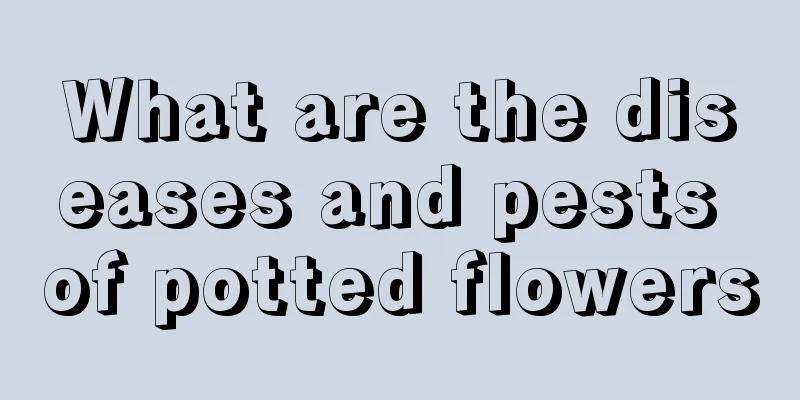What are the diseases and pests of potted flowers

Disease 1: Late spring coldharmThis is a non-infectious disease that mainly occurs in parts of the south of the Yangtze River and between the Yangtze River and the Huai River. By the end of March, the daytime temperature has reached above 20°C, and many people are eager to move their potted ornamental plants outdoors for conditioning and maintenance. However, at this time, cold air often moves south, and reversal weather of "late spring cold" occurs. The minimum temperature in the early morning often drops below 4°C, causing the new shoots and tender leaves of some flowers originating from the tropics to be "frozen". Common ones such as white orchid, Milan, jasmine, Clivia, Defen leaf, Syngonium, Fuchsia, Arrowroot, Anthurium, Poinsettia, etc. will seriously affect the normal growth in the spring of that year. WorkaroundKeep abreast of the weather forecast from the local meteorological station. If you encounter special weather conditions such as "late spring cold", a small number of potted plants that have been moved outdoors can be moved back to the greenhouse or indoors. If there are many potted plants moved outdoors, you can gather them together and cover them with a double layer of plastic film. In the Yangtze River Basin and areas to its north, you generally have to wait until after Qingming or the end of the "last frost period" before moving outdoors. You can cool down by opening doors and windows, adding electric fans and other measures, and then close the doors and windows at night to allow the house to gradually adapt to the outdoor environment. Disease 2: Powdery mildewharmIt mainly harms ornamental plants such as rose, crape myrtle, Mahonia, large-leaf boxwood, and bamboo knotweed. It mainly harms leaves, petioles, pedicels, flower buds and tender shoots. The affected parts are covered with a layer of white powdery substance. In severe cases, the leaves turn yellow, the tender leaves curl, shrink and thicken, the flower buds die, deformed flowers appear, and the tender shoots bend and shorten. WorkaroundSulfur powder fumigation: In March, an electric fumigator with built-in sulfur powder is used in the greenhouse for sealed fumigation, which has a good prevention and control effect. Disease 3: AnthracnoseharmIt mainly harms camellia, sasanqua, Yemen iron, hydrangea, Clivia, dieffenbachia, orchid, spider spore, epiphyllum, rubber tree, cyclamen and other plants in the greenhouse. It mainly harms leaves, young shoots and fruits. The lesions are nearly circular and gray-brown in color. Later, the lesions turn into gray-white with obvious concentric rings and whorled (or scattered) small black spots. WorkaroundThe density of flower pots and the spacing of plants and rows can improve ventilation conditions. When the soil in the pot becomes dry, water it appropriately to increase the resistance of the plant. In the early stage of the disease, use 500 times diluted 80% anthrax thimerosal wettable powder or 800 times diluted 50% polysulfide suspension, spray alternately once every 10 days for 2-3 times in a row. Disease 4: Botrytis cinereaharmAs the temperature rises, excessive humidity and poor ventilation will still cause gray mold to become one of the main diseases of indoor flowers. It harms potted flowers such as gerbera, rubber tree, cineraria, cyclamen, poinsettia, geranium, begonia, green ivy, Ixora, hibiscus, and anthurium, especially the leaves and petals, which are seriously susceptible to the disease. WorkaroundAfter March, you need to increase ventilation and light transmission, reduce indoor air humidity, and avoid spraying water on the leaves in the evening to prevent moisture from remaining on the leaves for a long time. For plants in the early stage of the disease, use 500 times diluted 65% mancozeb wettable powder or 1000 times diluted 50% carbendazim wettable powder around noon, spray alternately once every 10 days, for 2-3 times in a row. Disease 5: Sooty diseaseharmIn March, due to poor indoor ventilation and high humidity, piercing-sucking pests such as scale insects, aphids, and whiteflies cannot be completely eliminated. Sooty mold disease will still occur on the leaves, flowers, and fruits of plants such as citrus, Milan, hibiscus, white orchid, Michelia, fishtail palm, banyan, camellia, bamboo palm, azalea, gardenia, holly, and camellia. WorkaroundImprove indoor ventilation and kill aphids, scale insects, whiteflies and other insect vectors that cause sooty mold disease in a timely manner. A small number of leaves on some plants are infected with sooty mold. You can use a damp cloth dipped in low-concentration detergent water to wipe off the sooty mold layer. In the early stage of the disease, you can use 500 times diluted 50% methyl sulfur suspension or 500 times diluted 75% benomyl wettable powder to spray the branches and leaves of the infected plants once every 15 days for 2-3 times. Pest 6: Scale insectsharmFor potted ornamental plants placed in the greenhouse, scale insects are still the main type of pest due to restricted ventilation, insufficient light and high humidity. Such as the green cottony scale on kumquat, the gray mealyscale on yew, the mealyscale on hibiscus, the bran mealyscale on Clivia, the tortoise wax scale and red wax scale on camellia, the horned wax scale on holly, the black helmet scale and oyster shield scale on cycads, the wheel shield scale on roses, the white shield scale of Michelia and white orchid, the bran shield scale on bergamot, the giant tumor oyster scale on orchid, the white shield scale on bamboo palm, the round shield scale on ivy, the coconut round shield scale on Areca palm, and the arrow-pointed shield scale on Osmanthus fragrans, etc. The types of scale insects on each flower are very different. Prevention and treatment methodsIf scale insects appear on a small number of plants in the home, you can use cotton swabs dipped in 75% of alcohol to wipe off the living insects, or use cotton swabs dipped in laundry detergent to wipe off the insects. For smaller scale insects, such as the Sharp-nosed Scale and the White-shielded Scale, you can use transparent tape to remove the living insects. Alternatively, you can spray with 2000 times diluted 25% cypermethrin wettable powder once every 15 days for 2 times in a row. Pest 7: AphidsharmAs the temperature rises and the amount of watering increases, the damage caused by aphids on indoor ornamental plants will become more serious. Aphids suck the sap from new branches and leaves, which will affect the normal growth of the plant after spring. Prevention and treatment methodsFor a small number of aphids on plants, you can first sprinkle cigarette butts, wood ash or slag ash on the insect bodies and leaves. After about 1-2 hours, rinse them with clean water to kill most of the aphids. Pest 8: WhitefliesharmThe main one is the greenhouse whitefly, which harms cineraria, hibiscus, rose, nasturtium, and lantern flower; the second is the citrus whitefly, which harms kumquat, golden bean, daisy, bergamot, rose, white orchid, and Milan, etc. Their harmfulness cannot be underestimated. Prevention and treatment methodsWhen the occurrence is serious, use 2000 times diluted 10% imidacloprid wettable powder or 2500 times diluted 25% cypermethrin wettable powder. |
<<: Prevention and control methods of asparagus fern blight and yellowing disease
>>: Diseases and Pests of Medal Flower and Their Control
Recommend
How to grow Lithops to get double
1. How to get a double If you want to see the phe...
Cultivation methods and precautions of Roselle
Soil selection They are relatively drought-tolera...
How to grow succulent peach to a jelly color
Succulent peach growing conditions The peach tree...
The growing environment and local conditions of the cocoa tree
Cocoa tree growth environment and conditions The ...
How to make peach egg bloom, peach egg succulent pictures
1. How to make the pot explode 1. Suitable soil: ...
The most bizarre plants in the world
Rafflesia Rafflesia arnoldii, also known as the R...
What fruits are suitable for planting in Jiangxi? What fruits are mainly produced?
Jiangxi is rich in fruits Jiangxi has a superior ...
The effect of osmanthus fragrans
Medicinal effects of osmanthus fragrans Osmanthus...
Maintenance of common flowers-watering
camellia Now water it once every 4 or 5 days, and...
Rhododendron pests and control methods
Azalea Pests - Red Spider Mites Red spider mites ...
Preparation and use of osmanthus fertilizer
Osmanthus suitable for flower fertilizer When pla...
Homemade Insect Recipes
In the process of growing flowers and plants, we ...
When is the time to repot the crabapple? What should I do if the leaves are dry after repotting?
1. Time to change pots If you want to repot the c...
How to propagate the cut branches of Desert Rose (pruning and grafting methods and precautions)
How to prune and graft Desert Rose Desert rose ha...
When is sugar cane in season? Will eating sugar cane make you fat?
1. When is the season for maturity? It is an autu...









